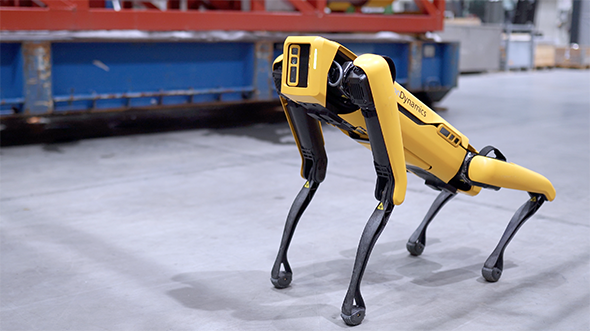Google, Facebook, Amazon, Tesla, Intel, IBM, Microsoft, and Uber: Other than the Internet, what’s the one investment all of these technology companies have in common?
I’ll give you a hint. It isn’t social media, mobile phones, or wearable devices.
It isn’t solar power, fuel cells, or any other kind of renewable energy source, either.
It’s a rapidly developing industry that’s already begun making its way into consumers’ homes. It’s also been the driving force behind industrial manufacturing for years now.
The automobile industry relies on it as do a slew of semiconductor fabricators.
It’s the one technology Bill Gates believes will be “bigger than the PC”… and perhaps the only thing Elon Musk admits he feels threatened by.
2018 was the strongest year on record for this industry in North America, with 2019 marking a close second. Globally, we’re looking at ~$16.2 billion in industrial revenue every year.
And as a result of recent advances, the cost of this technology has begun to plummet. Workers around the world are getting frantic, as the Boston Consulting Group predicts a massive drop in labor costs (as much as 33% in certain countries) over the next decade.
If you haven’t guessed, I won’t string you along any further…
The common investment between every one of the technology companies mentioned above is none other than robotics.
Jeff Burnstein, president of the Robotics Industry Association, puts this rapidly advancing sector in clear terms:
This is an extremely exciting time to be involved in the robotics industry. Record sales performance, groundbreaking innovation, and increasing consumer interest all make the robotics industry so dynamic.
Dynamic, indeed — the applications for robotics are now touching jobs we once thought impossible.
From fighting fires to fighting deadly viruses, robots are gaining an increasing amount of relevance throughout the world. They’re also gaining an increasing amount of attention…
That’s because robots are no longer just hiding in factories where no one can see them. They’re stepping out (both figuratively and literally) into the real world, under the wing of well-respected, multibillion-dollar technology companies.
See Spot Run
Take, for instance, this four-legged commercial robot from Boston Dynamics. The K-9 robot, appropriately named Spot, uses the same technology as Google’s driverless vehicles to autonomously navigate in factories and warehouses.

Boston Dynamics originally built robotics solely for military research, but the company recently began selling its robots commercially for a variety of applications. Spot is used in mining operations for routine tunnel inspections, in hospitals to deliver supplies, and at oil and gas sites to monitor pressure gauges.
Spot, though, is just the beginning for Boston Dynamics. The company’s humanoid robot Atlas is fast approaching practical commercial application.
Soon enough, people will be picking out a personal robot assistant the same way they shop for a car.
Stay on top of the hottest investment ideas before they hit Wall Street. Sign up for the Wealth Daily newsletter below. You’ll also get our free three part report, “After Apple: The Next Big Thing in Consumer Electronics“.
Not So Elementary
Then there’s IBM’s artificial intelligence system Watson. While not a robot on its own, it could very well be the brain of many robots in the future. In fact, Watson recently found its first physical body in a Japanese humanoid robot named Pepper.
Specifically, Watson schools Pepper in the area of emotional intelligence. Not only will robots be there to serve our physical needs, but they’ll soon be empathetic enough to offer therapeutic services as well.
Unlike most other cognitive technologies, Watson can learn over time, much in the way a human brain is able to. It also uses the concept of probability, which allows for more flexibility in its behavior.
The answers that Watson gives ultimately depend on context because, as IBM VP Steve Gold explains, “The world is seldom absolute.”
And IBM isn’t the only company seeking the holy grail of true artificial intelligence, or deep-learning, so to speak.
Facebook, for one, recently set up the Facebook AI Research lab (FAIR) and opened its deep-learning software to public developers. Paired with a recent job opening at the company, it’s near certain the company is pursuing intelligent robotics (taken from the company’s career page):
Facebook is seeking an Electrical Engineer to join our Strategic Engineering and Development Team. Our company is constantly pushing the limits of innovation. This person will be responsible for designing electrical system and circuitry for Industrial Automation and Robotics development.
We’ve also seen recent robotic initiatives and investments from:
- Uber: Carnegie Mellon and Uber have teamed up to build a driverless car lab, presumably for the purpose of creating driverless taxis.
- Intel: The company’s 21st Century Robot Program is looking to build an open-source, 3D-printed robot users can personalize for their own needs.
- Apple/Foxconn: Installing nearly 1 million factory robots over a three-year period.
- Amazon: Plans to launch a fleet of automated delivery drones so you can get your packages in as quickly as 30 minutes.
Within less than five years from now, the service-robotics market alone is expected to surpass $34 billion. This would make for an astonishing CAGR of ~21.5% between 2020 and 2025.
Including both industrial and non-industrial segments, Berkshire Hathaway’s Business Wire reports that the robotics industry will reach $248.5 billion annually by 2025, up from just $48.9 billion in 2018.
It’s easy to see from these numbers that robotics truly is the next big thing. Whether you’re a professional in the industry or a humble retail investor, this is a sector you have to expose yourself to, plain and simple.
Here’s how to get started on that journey today.
Until next time,
![]()
Jason Stutman
